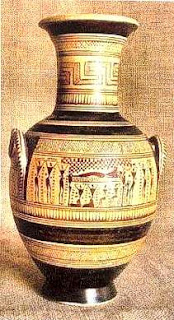 Even in the Bronze Age, the Greeks took advantage of oxidizing and reducing kilns to produce a shiny black slip on a cream, brownish, or orange-buff body, the shade depending on the type of clay. At first, decorative designs were abstract. By the Middle Bronze Age (2000-1500 BC), however, stylized forms from nature appeared. By the Late Bronze Age, plants, sea creatures, and fanciful animals were painted on pots of well-conceived shape by the Mycenaeans, who were initially influenced by Cretan potters. Athenian geometric style replaced the Mycenaean about 1000 BC and declined by the 6th century BC. Large kraters in the Geometric style, with bands of ornament, warriors, and processional figures laid out in horizontal registers, were found at the Dipylon cemetery of Athens; they date from about 750 BC.
Even in the Bronze Age, the Greeks took advantage of oxidizing and reducing kilns to produce a shiny black slip on a cream, brownish, or orange-buff body, the shade depending on the type of clay. At first, decorative designs were abstract. By the Middle Bronze Age (2000-1500 BC), however, stylized forms from nature appeared. By the Late Bronze Age, plants, sea creatures, and fanciful animals were painted on pots of well-conceived shape by the Mycenaeans, who were initially influenced by Cretan potters. Athenian geometric style replaced the Mycenaean about 1000 BC and declined by the 6th century BC. Large kraters in the Geometric style, with bands of ornament, warriors, and processional figures laid out in horizontal registers, were found at the Dipylon cemetery of Athens; they date from about 750 BC.Attic potters introduced black-figure ware in the early 6th century. Painted black forms adorned the polished red clay ground, with detail rendered by incising through the black. White and reddish-purple were added for skin and garments. Depictions of processions and chariots continued; animals and hybrid beasts (particularly in the Orientalizing phase that followed the Geometric period) were also shown, at times surrounded by geometric or vegetal motifs. Such decoration was always well integrated with the vessel shapes, and the iconography of Greek mythology can be identified. Beginning in the 6th century, the decoration stressed humans far more than animals. Favorite themes included people and gods at work, battle, and banquet; musicians; weddings and other ceremonies; and women at play or dressing. In some cases, events or heroes were labeled. Mythological and literary scenes became more frequent. Potters' and painters' names and styles have been identified, even when they did not sign their works.

Red-figure pottery was invented about 530 BC, becoming especially popular between 510 and 430. The background was painted black, and the figures were left in reserve on the red-brown clay surface; details on the figures were painted in black, which allowed the artist greater freedom in drawing. The paint could also be diluted for modulating the color. Secondary colors of red and white were less used; gold was sometimes added for details of metal and jewelry. Anatomy was rendered more realistically, and after 480, so were nuances of gesture and expression. Although Athens and Corinth were centers for red-figure pottery, the style also spread to the Greek islands. By the 4th century BC, however, it declined in quality. Another Greek style featured outline drawing on a white ground, with added colors imitating monumental painting; these vessels, however, were impractical for domestic use.
Source







No comments:
Post a Comment